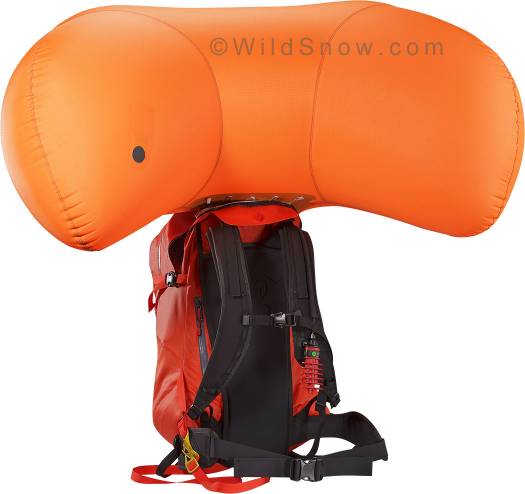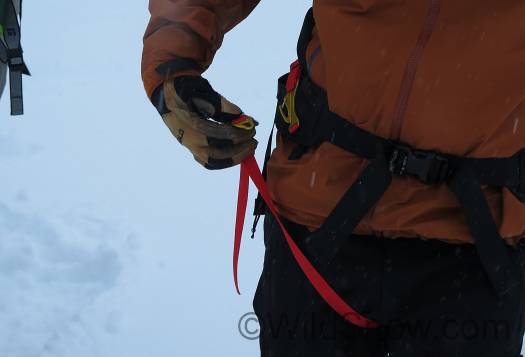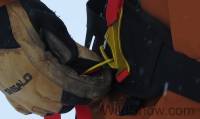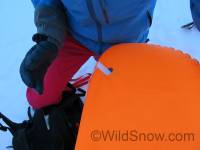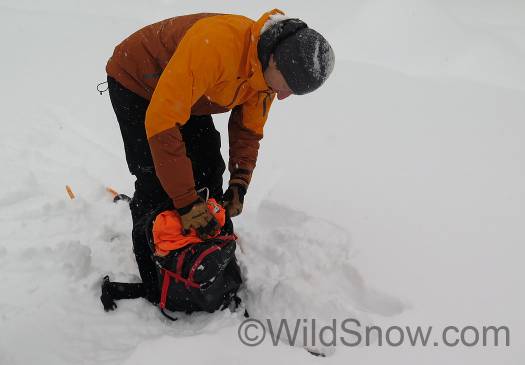This is getting fun. A bit pricey, but fun. I’ve lost count of how many brands and models of compressed gas airbag backpacks you can get. Now we’ve got two competing brands offering electric “blower” packs, totally viable options with features such as multiple balloon inflations on one battery charge, easy air travel, and most importantly, zero hesitation to pull the trigger (a very real problem that’s caused deaths according to some studies).
I recently spent a few days in Canada, listening to airbag engineering details from the Arcteryx industrial designers — and actually using the pack while backcountry skiing (including a number of inflations and re-packs). In the end, I had enough for a take. (Officially spelled Arc’teryx but with a nod to carpel tunnel syndrome we forgo the apostrophe.)
“Our intent here was to design a superb ski touring pack that just happens to have a balloon that pops out of its head.” That’s how designer Pete Hill describes the Arcteryx philosophy for Voltair 20L & 30L packs. “We also wanted a super reliable system,” he added, “So we minimized the electronics (no electricity in the trigger cable) and put an amazing amount of effort into how the bag exits the pack during an event.”
From there, the list went on. And on. So that’s the way I’ll organize this review. Just as Pete suggests, I’ll look at this as a backpack first, then talk about the balloon that pops out.
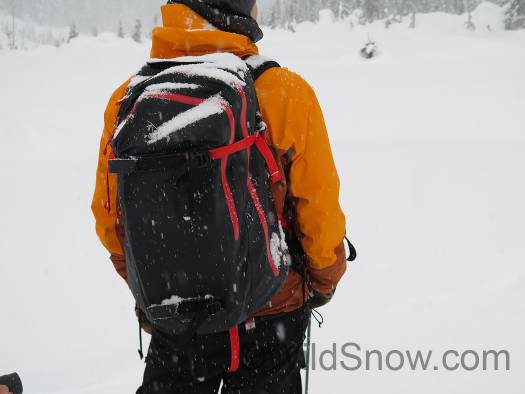
30 liter Voltair 30L from the rear. Note single set of compression straps. A-frame ski carry not allowed, due to balloon.
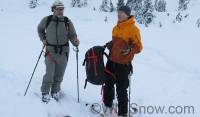
Designers Gord Rose and Peter Hill gave up one powder run to instead expound on the virtues of Voltair, impressive dedication to the cause.
Overall look and feel
Arcteryx is known for “clean” backpacks, Voltair is no exception. These are panel loaders with one partition and a place for the balloon. A simple tool and skins area is provided to the outside, while the compartment closer to your back has nothing but a small goggle pouch near the top, and the surprisingly small and flat electrical components. You’ll find a single compression strap on each side, near the top. That’s to discourage A-frame ski carrying (airbag can’t inflate). Instead, a strap Velcro loop system is provided on the back face of the bag for diagonal skis or alpine tools.
I guess I should mention color (yawn). Voltair 20 liter is “Cayenne” red, 30 liter is pretty much black though it probably has a fancy color name. We prefer black backpacks if they’re getting heavily used or traveled worldwide. Red attracts attention when you don’t want it and gets dirty quickly. On the other hand, red is always wonderful for photography — get out that selfie stick!
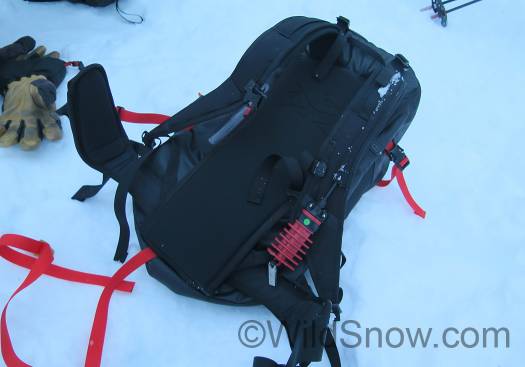
Somewhat basic suspension etc., and that’s good. Waist belt ‘pivots’ a bit. Probably unnecessary but one can’t have a pack without some sort of pizzazz.
Comfort
I had no issues in the comfort department. Torso length was perfect for me, long enough to feel like a “real” backpack yet not so tall as to resemble wearing an oversized pickle. Torso length is not adjustable, and the pack does not come in different lengths. Belt and shoulder strap padding is perfect for my taste, though if you’re packing the 30L to the gills with heavy stuff it’s possible you might want a little more width in the straps.
Fabric, zippers, etc.
Have to say I love the Arcteryx “waterproof, taped AC2” way of building a pack, and it was tested in wet snow and rain. Worked. AC2 is a double coated pack fabric that essentially creates a dry bag you could use on the river (without the zippers). They make stuff like that up in the coastal ranges because it rains a bit. The zippers are the usual per the big Vancouver bird, waterproof without covers. Love those too.
Volume
If I could get all the airbag backpacks together and measure actual volume vs. claimed, I’ll bet Voltair would be one of the best in class. Both models have a surprising amount of room inside. While doing our Arcteryx factory visit during this press trip, I did see their pack volume measuring system. Nothing surprising or unusual: a bucket of plastic beads. (This was next to the skunk works where they were making weird one-off gear for their athletes, sorry, no pictures.) So, their volume measuring isn’t somehow causing them to add volume, they simply did it to be sure a 30 liter pack is a 30 liter pack — excluding the airbag guts.
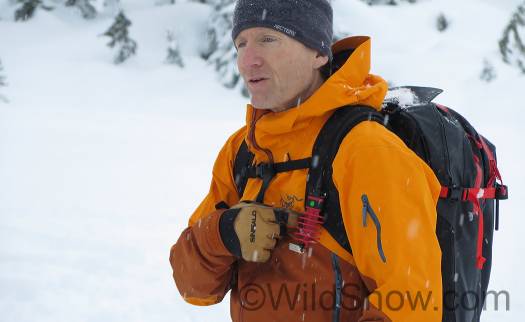
The trigger handle is there, but I’d like it slightly bigger and sticking out from the pack strap a bit more.
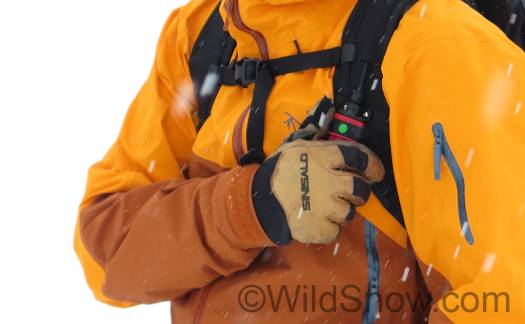
Green dot indicates trigger handle is rotated to the armed position. It’s easy to rotate off to prevent accidental deployment.
Airbag trigger
Let’s be clear that Voltair differs from the other brand electric airbag by having a fully mechanical trigger that contains no electronics. It’s said this is to avoid complexity and “increase reliability.” Time will tell. Meanwhile, I can tell you that the trigger handle is indeed nicely shaped, and locks/unlocks with a simple twist. Mode (locked/unlocked) is indicated by a green or red dot. Low tech. If the electricity is turned on (switch on the battery) and you forget to unlock the handle, you can unlock while you pull by twisting your hand. Probably a good habit to get into. I did find the handle a bit small and too close to the shoulder strap for panic grasping. Practice is key here as with all other airbag rucks. A rigging hole is provided so you can string a cord from the trigger over to the opposite shoulder strap, thus creating a “guide” ripcord. In extreme conditions, while for example wearing bulky mittens, you’d probably want to do that.
Harness (leg loop)
This is where Arc’ broke the mold. While their leg loop does clip to the side of the waist belt, it’s actually integrated to the balloon with a length of webbing. The pack thus does NOT need an annoying “safety” buckle on the waist belt. Instead, you get a normal plastic buckle that’ll clip as fast as your non-airbag friends (and which in truth is probably plenty strong).
The designers told me the leg-loop-to-pack attachment was inspired by ice climbing clips. It’s a small spring gated device that you clip into similar to a carabiner, but operates easily with one hand for the exit once you get a fancy little flick with your hand figured out. As with other airbag packs YOU CAN DIE IF YOU DON’T USE LEG LOOP, so how these things work is one of the most important aspects of a balloon pack. We obsess on the size and shape of the balloon, but how it’s attached to our bodies is way more important. Me, I’d still like to see airbag leg loops built into pants, with a nice little clip down by the hip pocket. We do have a sewing machine. Another WildSnow mod?
One of my only cons with Voltair is while the leg loop clip does “snap” nicely, I found it difficult to see with bulky clothing, and a bit too far to the rear for easily clipping. It appeared both things could be remedied by mounting the clip a few centimeters farther forward on the waist belt. But like anything in engineering, change one thing, change something else. So perhaps the clip needs to stay where it is.
Airbag balloon
Nothing paradigm shattering here. a big sack of coated nylon that is indeed shaped to perhaps provide some cervical protection (but not advertised to do so). Volume is 150 liters, which engineers tell me is perfectly adequate for an average size person with a day-pack load. If you’re a 250 pound NFL linebacker needing to carry a load to Denali high camp, you might need a larger airbag. If so, talk to the Arcteryx custom shop, they might be getting bored and need something fun to work on. On the other hand, you’re not a hockey player so don’t even think about it.
The balloon does inflate quickly with lots of pressure, due to the screaming centrifugal blower — really the heart of the system. It is loud. The bag ends up surprisingly taut. Volume and pressure of the blower can overcome small tears.
You deflate by inserting a small hollow plastic tube into a fabric valve on the bag. Deflation is fairly quick (just a few minutes) but I could see the tube and valve being a bit larger for even quicker venting. You leave the tube in while you pack, then remove at the final stuffing of the balloon. No special folding or other tedious packing is required, you just stuff the bag in and re-do the exploding zipper. If you make a mistake and leave the deflation tube in the balloon, it’ll still inflate (which is perhaps the reason the deflation system isn’t larger.)
I do have a serious point to make about avalanche airbags. There are two issues with the balloon that current standards do not address — and the industry tends to dance around. First, since around a quarter of avalanche deaths involve serious injury, if we’re going to haul around all this expensive and heavy technology shouldn’t it provide some trauma protection? Secondly, in a larger avalanche you quickly loose all body control, twirling, tumbling and “tomahawking” at speeds sometimes approaching 100 mph. Lengthening your body with a balloon above your had could exacerbate this. Keep that in mind, oh ye of total faith in avalanche airbags. Sure, a helmet might be helpful, but remember that current ski helmets actually provide little protection, in some cases, in my opinion being little better than a few layers of cardboard and bubble wrap taped to your head.
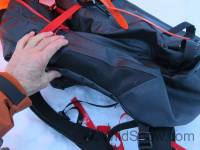
Tower of power intake tube, enclosed in mesh fabric. Designers told me that during testing they got reliable inflations even with the external air vent compromised with tape, and they’re not even sure the intake tube has to be so large.
Plumbing
While the guts of this thing took years to develop, simplicity and compact size indicate a mature state of design. There really is not much to see inside the pack. Battery is a big flat brick with a red switch on the side (you turn the pack on-off here, through a small zipper on the outside of the pack). Small “black box” controller lives between battery and blower. Blower is at the end of a big tapered air intake tube known among Arteryx insiders as the “tower of power.” When you pull the trigger, you switch on the blower and also unlatch a small catch on the airbag’s exploding zipper.
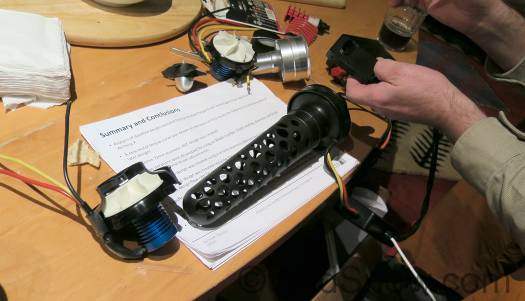
Cutaway of impeller at left, tower of power air intake tube to right, blower mounts on the right end of the tube. The impeller required years of development that included hiring a couple of boffins from the UK to do advanced computer simulations. Injection molding the resulting design is another challenge, as it has to be incredibly strong and free of flaws. The thing spins at 40,000 rpm and has to deal with events such as frozen condensation getting sucked into the blades. An impressive bit of engineering, if I do say.
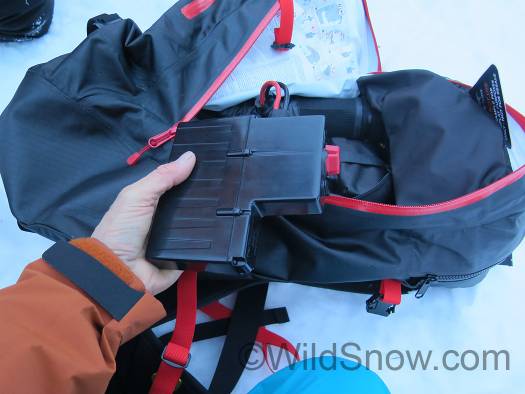
The 22.2 volt lithium-polymer battery weighs 800 grams and in my opinion is way over done, but required by regulations and reliability concerns. Battery DNA hardens to the radio controlled model car and jet community, where amazing things are being done with stored electricity.
Electrical
The black box is a sealed system. Interestingly, Arcteryx can download info from a data logging component, with permission of user. They hope to use this data (temperatures, number of inflations, and probably more) to figure out what is truly necessary for effective use of electrical airbag rucksacks. Current airbag standards are perhaps overly strict in terms of how many inflations per a given temperature. The question: “How many people really need a pack that inflates several times at negative 30 degrees centigrade (-22 F)?” That is ridiculously cold. Perhaps a better standard would be a simple alarm built into a smaller battery that began beeping if you actually did go out for a ski at 30 below zero, warning you that you might die of hypothermia.
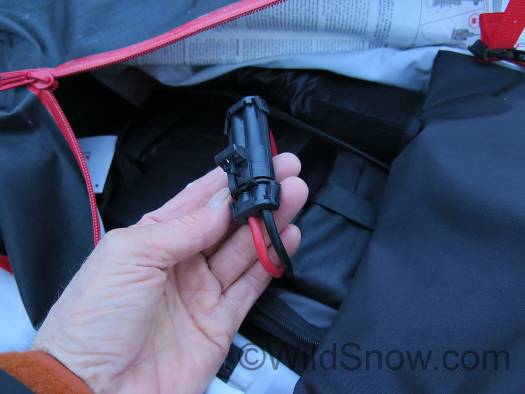
Battery is somewhat ‘dumb’ (though it does have some data recording capability) and connected with a beefy and moisture sealed automotive connector (Delphi Weatherpack, high amperage). The pack does have an external led indicator so you know when it’s turned on. It’s said you can leave it switched on for several days without any significant drain on the battery, though it’s of course better to switch it off and keep the battery charge topped. It takes literally seconds to remove and replace the battery.
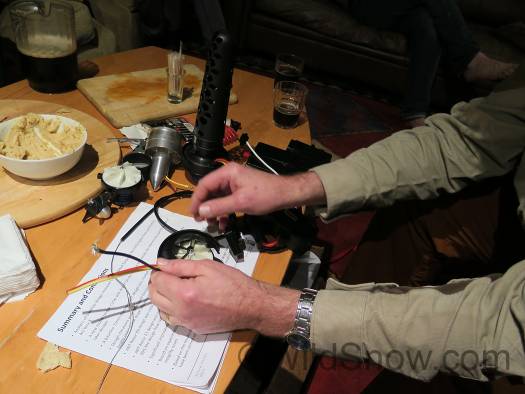
Gord showing off the blower wires. Wires? You can’t just stick a chunk of hardware store wire into a backcountry safety device. These wires are special for high amperage and cold temps. Thousands of tiny copper strands, covered with a primo layer of silicon. Flexible, reliable, and won’t burst into flames while you’re riding out the avy.
So, overall what does it feel like to ski with the Voltair?
Most importantly for me, I swear I did notice this pack weighs a few ounces less (progress!) than a roughly equivalent competitor. It carries fine, standard plastic pack buckles are no surprise, and it’s plenty waterproof. We did a simulated avalanche (!) inflation that involved triggering while skiing down fairly rough terrain. I pulled, stayed on my feet, made some (sort of) turns and then easily repacked the bag. That’s the key with electric balloon packs. Pull when you want, pack it quickly, and get on with the day. No fuss. Lovely.
Catalog weights
Voltair 30L, 3465 grams, 7.6 pounds
Voltair 20L, 3235 grams, 7.1 pounds
Voltair available for purchase fall 2016, 20L – USD $1,650, 30L – USD $1,700
WildSnow.com publisher emeritus and founder Lou (Louis Dawson) has a 50+ years career in climbing, backcountry skiing and ski mountaineering. He was the first person in history to ski down all 54 Colorado 14,000-foot peaks, has authored numerous books about about backcountry skiing, and has skied from the summit of Denali in Alaska, North America’s highest mountain.

